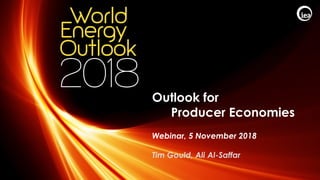
Producer Economies Webinar
- 1. © OECD/IEA 2018 Outlook for Producer Economies Webinar, 5 November 2018 Tim Gould, Ali Al-Saffar
- 2. © OECD/IEA 2018 Context Now more than ever, fundamental changes to the development model in key oil and gas exporters countries look inevitable Shale revolution Fuel efficiency & fuel switching, including electric vehicles Response to climate change & air pollution Producers are a very diverse group; this report focuses on six: Iraq, Nigeria, Russia, Saudi Arabia, United Arab Emirates & Venezuela Recent high prices are a double-edged sword; higher revenues provide the means to reform, but reduce the urgency & accelerate structural changes in demand Success – or failure – of these reform efforts has wide-ranging impacts for energy markets, energy security & pathways to reach environmental goals
- 3. © OECD/IEA 2018 A rollercoaster ride Net income from oil and gas in six selected producer economies The fall in oil prices that started in 2014 brought into sharp relief some risks associated with high dependence on hydrocarbon revenues 200 400 600 800 1 000 1 200 2010 2011 2012 2013 2014 2015 2016 2017 Billiondollars(2017) Natural gas Oil Net income: Venezuela Nigeria United Arab Emirates Iraq Saudi Arabia Russia
- 4. © OECD/IEA 2018 Job creation and productivity Labour productivity in selected countries in the Middle East and North Africa Declines in labour productivity in producer economies underpin the priority in reform programmes to boost private sector activity 50 100 150 200 250 300 1970 1980 1990 2000 2010 2018 Index(1970=100) Egypt Tunisia Morocco Algeria Saudi Arabia Iraq United Arab Emirates Qatar
- 5. © OECD/IEA 2018 Uncertainty over future hydrocarbon revenues High oil price Low oil price 500 1 000 1 500 2 000 2 500 2036-40 Dollars(2017) 2031-352026-302021-252016-202010-15 Per capita net income from oil and gas Demographic pressures keep the imperative for reform strong even with a higher oil price The arguments for change are inescapable in case of lower prices and/or faster transitions
- 6. © OECD/IEA 2018 Strategic responses The reform agenda needs to be much wider than energy: Improved conditions for private sector growth Ways to limit the disruptive effects of the commodity cycle Reforms to financial and labour markets But the prospects also depend on a well-functioning energy sector: Capturing more value from hydrocarbons, e.g. via petrochemicals
- 7. © OECD/IEA 2018 The search for more value at home Changes in crude oil and NGLs supply and demand in the Middle East Moving further down the value chain is a central part of many Middle East diversification strategies, squeezing the additional crude available for export 1 2 3 4 5 6 7 Additional supply (2017-40) Additional consumption (2017-40) mb/d Crude and condensateOther NGLs Refinery Petrochemical feedstock Reduction in direct crude burn Additional crude exports
- 8. © OECD/IEA 2018 Strategic responses The reform agenda needs to be much wider than energy: Improved conditions for private sector growth Ways to limit the disruptive effects of the commodity cycle Reforms to financial and labour markets But the prospects also depend on a well-functioning energy sector: Capturing more value from hydrocarbons, e.g. via petrochemicals Using natural gas as a way to support diversification Pursuing cost-effective deployment of low-carbon energy
- 9. © OECD/IEA 2018 The Middle East’s solar opportunity Solar PV could play a very cost-effective role in meeting growing power demand, especially for cooling, across the Middle East 30 60 90 120 150 2015 2020 2025 2030 2035 2040 DollarsperMWhExisting oil-fired generation at $40/barrel versus unsubsidised new solar PV in the Middle East New solar PV Existing oil-fired capacity at $40/barrel
- 10. © OECD/IEA 2018 Strategic responses The reform agenda needs to be much wider than energy: Improved conditions for private sector growth Ways to limit the disruptive effects of the commodity cycle Reforms to financial and labour markets But the prospects also depend on a well-functioning energy sector: Capturing more value from hydrocarbons, e.g. via petrochemicals Using natural gas as a way to support diversification Pursuing cost-effective deployment of low-carbon energy Phasing out subsidies that encourage wasteful consumption Ensuring adequate investment in the upstream Developing cleaner and more efficient energy technologies
- 11. © OECD/IEA 2018 Building on low-cost resources Finding and development costs of oil produced in high oil price case, 2017-2040 Adequate upstream investment, technology innovation and some of the lowest-cost resources can provide a solid platform for a more diversified economy 10 20 30 40 50 60 0 100 200 300 400 500 600 billion barrels Dollarsperbarrel(2017) Rest of world Producer economies 650
- 12. © OECD/IEA 2018 Conclusions A changing energy system is posing critical questions for countries heavily dependent on oil & gas revenue The reform process will be complex and challenging, but failure to take action would compound the hazards facing producer economies and global energy markets The process of change must be wider than energy; but it relies on a well-functioning energy sector as a source of revenue and comparative advantage Successful reform would open up a broader range of strategic options for producers, as well as new opportunities for engagement on a range of energy issues
